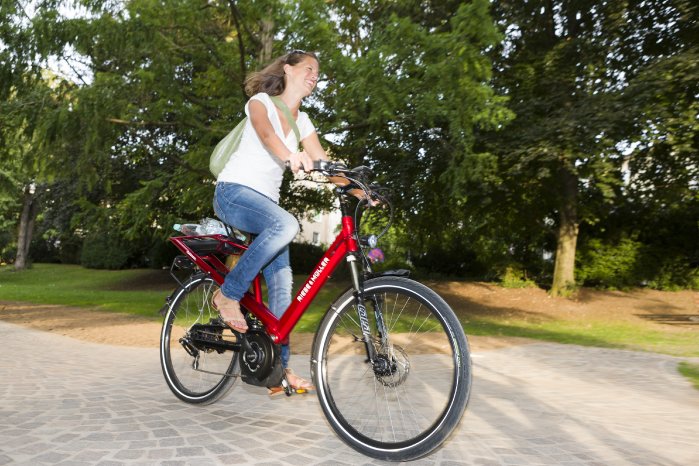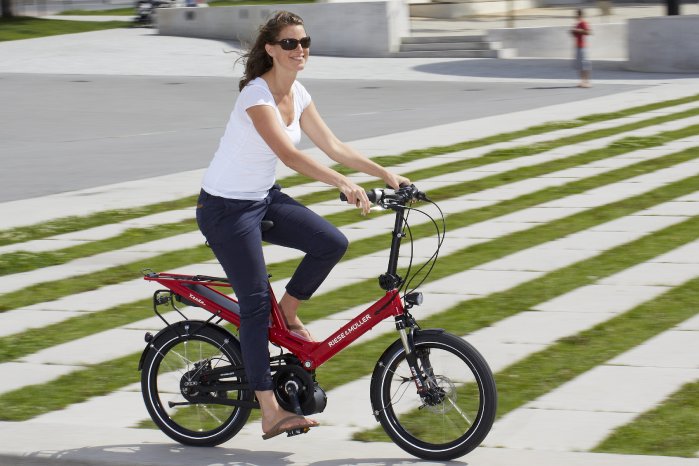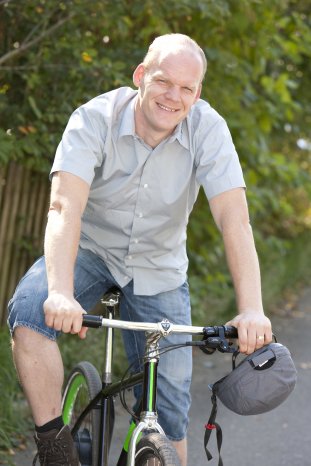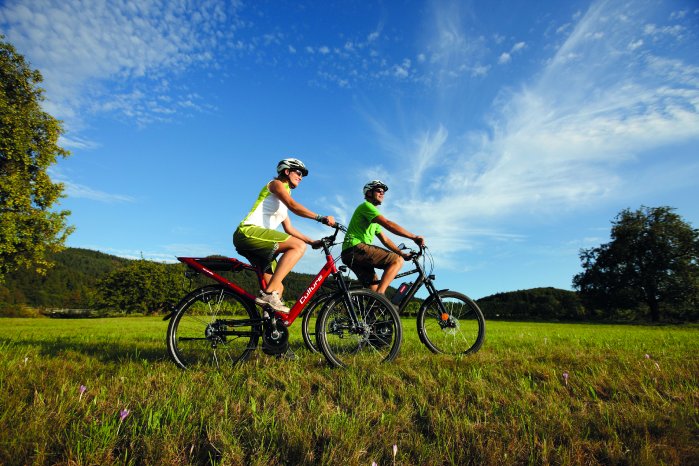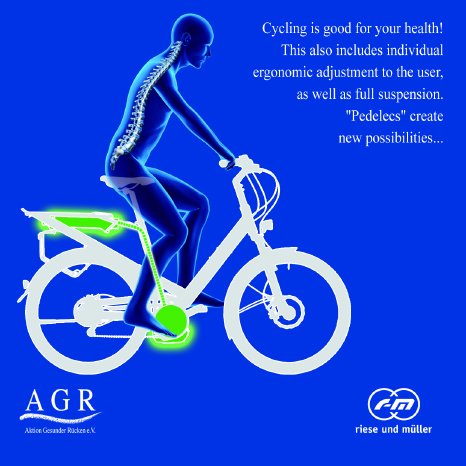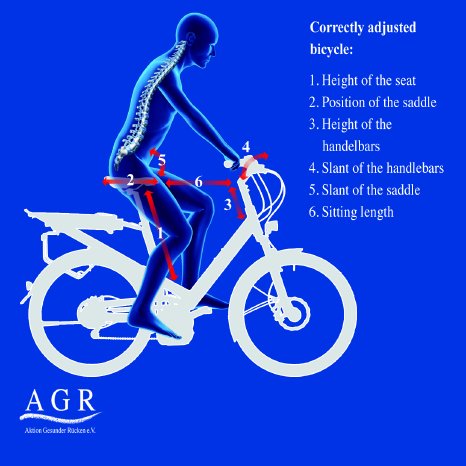"The bicycle clearly reflects changes in society", explains Gunnar Fehlau, cycling expert, author and head of the pressedienst-fahrrad (cycling information service). Advancing urbanisation, the demographic shift, growing environmental awareness and the trend for people to assume more responsibility for their own health - these are the current issues facing society and cycling, of this Fehlau is certain. Innovations are no longer reserved just for athletes and professionals but can also offer more comfort and safety in particular to health-conscious cyclists, thus enhancing their quality of life. The Campaign for Healthier Backs (AGR) talked to Fehlau about the latest developments.
AGR: Every year, cycling trends seem to emphasise the sporting aspects in particular. Are there also innovations for the back-friendly bike?
Gunnar Fehlau: For many years, the bicycle industry really only had one single category to address the issue of comfort for everyday and leisure bikes. Usually these were bikes produced at very low cost with a low frame to make it easy to get onto and off the bike. In combination with simple components, this resulted in a bike that was quite heavy and not very much fun to ride, while being on sale in the shops for a comparatively low price. These bikes didn't really invite people to take part in active exercise. Instead of encouraging the user and helping him to enlarge his radius of activity or expand his physical exercise bit by bit, the design and quality of these so-called senior citizen's bikes tended to cement the status quo of their users. Only a few bicycle manufacturers have followed the path to the really back-friendly bike. These need comfortable full suspension and a definitely sporty geometrical design together with a low step-through while at the same time featuring lightweight, functional and ergonomic components.
AGR: To what extent has the comfort bike had to change?
Gunnar Fehlau: There are three ways in which the comfort bicycle has changed and is still changing. Since the start of the new millennium, the bicycle industry has not only discovered the "best ager" generation as purchasers of simple bicycles: it now also understands that people who have reached the middle of their lives certainly appreciate what a good bicycle is worth and give increasing significance to quality. High-tech innovations have been passed on initially from racing bikes and mountain bikes to touring bikes and city bikes, before finally reaching those models geared specifically to the needs of people who appreciate a bit of comfort. Together with the low step-through, corresponding features include in particular good full suspension and ergonomic design together with brakes and gears that are easy to use, as well as good, reliable lights. Real comfort is then a combination of all these things. The Campaign for Healthier Backs has rightly drawn attention to these facts for several years now and also awarded the AGR seal of approval to particularly back-friendly bikes. This created the basis for the second development stage for what used to be the senior citizen's bike.
AGR: So it's been turned into a comfort bike not just by new technology. What does that really mean?
Gunnar Fehlau: The ideal comfort bike is a very individual thing. It has to be adapted to each person's own needs. In the end, most people remain very consistent throughout their lives. People who were very sporty in their youth will also prefer a sporty bike as a senior citizen. But this kind of sporty design has to be adapted to the particular individual and will therefore need different technical attributes. A young person's superlight, highly efficient racing bike with hard suspension may become a lightweight trekking bike with higher handlebars and moderate geometry before turning eventually into a comfortable bicycle with full suspension that still offers a dynamic performance.
AGR: Does this reflect the way society sees the best-agers?
Gunnar Fehlau: Yes, the way people see the last third of their lives has changed. An active approach to this phase in our lives enjoys high individual priority and is well accepted in society at large. In sociological terms, a certain shifting has taken place. Something has acquired a new significance or is treated with new value and acceptance. In this case, from rehabilitation bicycle to a vehicle for individual quality of life and mobility.
AGR: Then there's the third level which has changed the senior bike, which doesn't really exist, into a comfort bike ...
Gunnar Fehlau: Exactly, and this fits in precisely with one of the great present-day trends. Electronic solutions replace mechanical systems, digital instead of analogue. In the bicycle, this means electrified propulsion. The e-bike or to be more precise, the Pedelec, exemplifies a unique success story. It makes the bicycle an attractive means of transport for everybody. It keeps people mobile and active while helping them without making them look needy. The Pedelec principle where the motor only starts up when the cyclist actively presses on the pedals, takes the suffering out of cycling. This is unrelated to age and applies to all types of bike. Even racing bikes and mountain bikes are available in the electrified version, thus making them interesting for many more people.
AGR: How will this shape the development of the cycling market?
Gunnar Fehlau: The comfort bike of tomorrow is definitely electrified. This can even be said for most of the top quality everyday bikes. The cycling market has changed drastically over the last five years. The everyday bike with top quality features that does NOT have a motor is quite clearly on the defensive. This plays an important role for prices of up to €999,-; beyond that limit, the analogue bicycle is a touring bike, is used as sport equipment or it's an individually customised bike. While years back ago people opted for top quality gears, brakes and expensive dynamos, these same customers now reach for the Pedelec. Thanks to the motor, it now manages with simpler gears and without a dynamo. As far as brakes go, a good mountain bike standard is ideal. The Pedelec then costs about €1,000 to €1,500 more than the good bike used to, while being much more fun to ride and thus offering more quality of life. By the way, this added benefit is the reason why e-bikes are such a great success story, in contrast to the e-car. Germany's roads are used by more than 1.5 million e-bikes, but scarcely 10,000 e-cars.
For many years, the AGR has been focussing its expert attention on ergonomic aspects and individually adjustable cycling technology. One particular pioneer in this field is the bicycle manufacturer Riese & Müller (www.r-m.de) with a very wide choice of excellent bikes. More information about back-friendly daily routines and back-friendly everyday products (including bicycles) marked with the AGR seal of approval can be found at www.agr-ev.de/en.
Ergonomic requirements for back-friendly bicycles
- Framework geometry encourages an upright sitting position
- Adjustable height and tilt of the handlebars
- Adjustable, effective suspension (at the front and back)
- Saddle height, tilt and longitudinal position can be adjusted
- Low step-through
- Low weight
Additional requirements for e-bikes
- Battery range at least 40 km
- Battery is easily removed
(= weight reduction)
